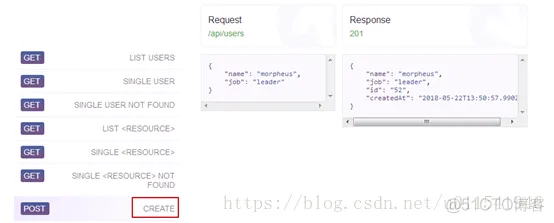几乎不计。所以,这个Java接口自动化测试框架的核心就是Get和POST请求方法的封装过程。
1.POST接口举例
浏览器打开 https://reqres.in/,下拉一屏。点击第一个POST请求,这个接口的介绍信息如下。

这个接口的作用是创建用户,参数是一个json类型的数据,一个name一个job,两个JSON对象。发送请求之后,返回的JSON数据有name和job和id,以及创建时间这几个数据。
2.Postman手动实现
我们先在本地postman环境,先来手动测试实现下这个post接口的请求过程。

这个post接口请求还是比较简单,很容易在postman上实现该请求。
3.Java代码自动化实现
我们已经可以正确地在postman上实现创建用户这个接口的手动测试,那么我们想要这个过程自动化实现,如何做呢。下面我在RestClient.java封装了两个方法,一个是带请求头信息的Get请求,一个是带请求头信息的POST请求方法。这篇,了解了POST请求方法,带请求头的Get方法封装就很好理解。
然后,我们需要写一个TestNG测试用例来测试下这个封装的post方法好不好用。由于我们去前面几篇文章介绍了TestNG测试get方法的代码,这里我们就直接拷贝和修改部分代码就行。
在写测试用例之前,我们需要提前准备好json数据,一般来说,在Java中JSON数据都是放在JAVA Bean类中,通过JSON把高级对象序列化成JSON对象。
在src/main/java中新建包:com.qa.data,然后新建一个Users.java,这个命名就参考接口的url单词就行。在postman或者网站该post方法,我们知道,需要name和job这两个json对象。我们新建一个bean类,同alt+shift+s,然后选择生成构造方法和set和get方法。
好了,在src/test/java下的com.qa.tests我们新建一个POST测试用例,现在我们的TestNG测试类代码如下:
建议,在写测试用例过程中,需要和postman上的请求结果参考,特别是Headers这里的键值对。这里留一个作业,上面我写了一个Get带请求头的封装方法,你可以对照postman中的请求头去写一个单元测试用例去测试下这个带headers的Get方法。
目前,Java接口自动化测试框架的核心部分,http请求方法的封装已经完成。接下里还有测试日志,测试报告,或者其他需要抽取优化的模块去完成。